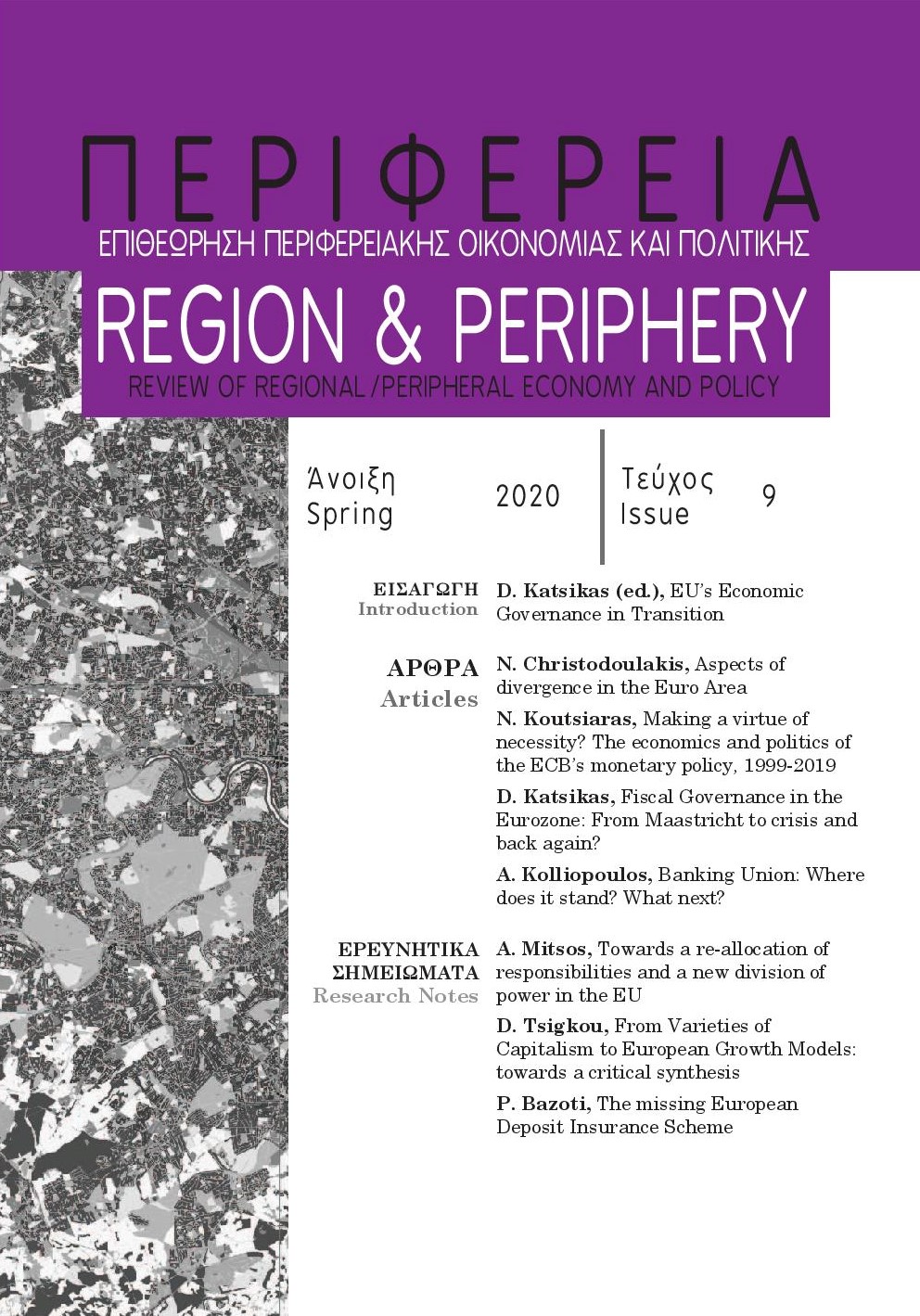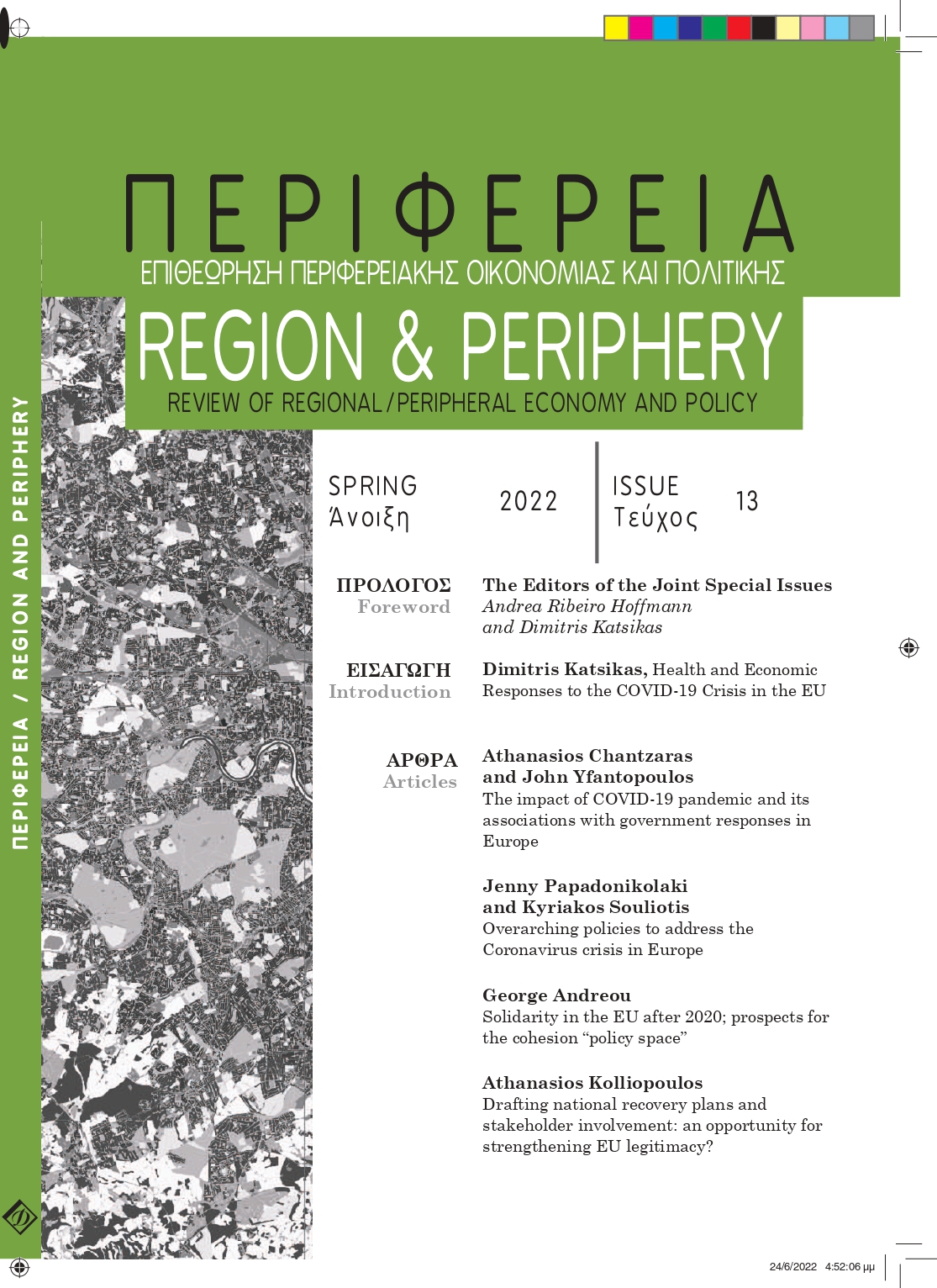REGION & PERIPHERY[129]Bénassy-Quéré A., M. Brunnermeier, H. Enderlein, E. Farhi, M. Fratzscher, C. Fuest, P-O. Gourinchas, P. Martin, J. Pisani- Ferry, H. Rey, I. Schnabel, N. Véron, B. Weder di Mauro and J. Zettelmeyer (2018), “Reconciling risk sharing with market discipline: A constructive approach to euro area re-form”, CEPR Policy Insight No. 91.Bénassy-Quéré A., M. Brunnermeier, H. Enderlein, E. Farhi, M. Fratzscher, C. Fuest, P-O. Gourinchas, P. Martin, J. Pisani- Ferry, H. Rey, I. Schnabel, N. Véron, B. Weder di Mauro and J. Zettelmeyer (2019), “Euro area architec-ture: What reforms are still needed, and why”, VoxEU.org, May 2.Best K. (2018), “Shared scepticism, different motives: Franco-German percep-tions of a common European safe asset”, Centre for European Affairs at the Hertie School, Berlin, October 26.Bickerton C., D. Hodson, and U. Puetter (eds) (2015), The New Intergovernmentalism, Oxford: Oxford University Press.Bofi nger P. (2018), “Euro area reform: No deal is better than a bad deal”, VoxEU.org, May 15. Brunnermeier M., L. Garicano, P. Lane, M. Pagano, R. Reis, T. Santos, S. Van Nieuwerburgh, D. Vayanos (2011), “European Safe Bonds: ESBies,” Euro-nomics.com.Brunnermeier M., H. James and J-P. Landau (2016), The Euro and the Battle of Ideas, Princeton and Oxford: Princeton University Press.Callaghan K. and F. Schnell (2005), Framing American Politics, University of Pittsburgh Press.Claessens S., M. Ayhan Kose and M. Terrones (2012), “How Do Business and Financial Cycles Interact?” Journal of International Economics 87 (1), pp. 178-190.Claeys G. (2018), “Are SBBS really the safe asset the euro area is looking for?”, bruegel.org, May 28.Comunale M. and F. Mongelli (2019a), “Who did it? A European Detective Story. Was it Real, Financial, Monetary and/or Institutional? Tracking growth in the Euro Area with an atheoretical tool”, Bank of Lithuania, Working Paper Series no. 70/2019.Comunale Μ. and F. Mongelli (2019b), “Euro Area Growth and European Institutional Reforms”, Bank of Lithuania Occasional Paper Series 24, Bank of Lithuania.Council of the European Union (2013), “Council agrees general approach on Single Resolution Mechanism”, Press Release, Brussels, December 18.perifereia t.9o.indd 12915/6/2020 1:18:04 μμ
ΠΕΡΙΦΕΡΕΙΑDe Rynck S. (2014), “Changing Banking Supervision in the eurozone: the ECB as a Policy Entrepreneur”, Bruges Political Research Papers 38/2014.Dell’Ariccia G., C. Ferreira, N. Jenkinson, L. Laeven, A. Martin, C. Minoiu, A. Popov (2018), “Managing the sovereign-bank nexus”, Working Paper Series No 2177, European Central Bank, September.Donnelly S. (2014), “Power Politics and the Undersupply of Financial Stability in Europe”, Review of International Political Economy, 21 (4), pp. 980-1005.Donnelly S. and P. Asimakopoulos (2019), “Bending and Breaking the Single Resolution Mechanism: The Case of Italy”, Journal of Common Market Studies, November, pp. 1-16.Draghi M. (2018), “Risk-reducing and risk-sharing in our Monetary Union”, Speech at the European University Institute, Florence, May 11.DW (2013), “Germany opposes EU banking closure authority”, Deutsche Welle, July 11.DW (2018), “How France’s Emmanuel Macron wants to reform the EU”, Deutsche Welle, March 16.DW (2019), “Germany’s Scholz seeks compromise on EU banking plan”, Deutsche Welle, November 6. ECB (2018), “ECB will directly supervise 119 banks in 2019”, Press Release, December 14. El Mundo (2013a), “Bruselasquieretener la última palabra para liquidar ban-cos”, July 10.El Mundo (2013b), “La UniónBancaria se topa con un nuevoobstáculo”, September14. Enria A. (2017), “European banks’ risks and recovery - a single market perspec-tive”, European Banking Authority, January 30.Epstein R. and M. Rhodes (2016), “The political dynamics behind Europe’s New Banking Union”, West European Politics, 39 (30), pp. 415-437.ESM (2019a), “Explainer on ESM reform and revisions to the ESM Treaty”, Press Release, June 24.ESM (2019b), Safeguarding the euro in times of crisis: The inside story of the ESM, Luxembourg: Publications Offi ce of the European Union. ESM Seminar with Andrea Enria, EBA Chairperson, Luxemburg, January 30. Euobserver (2019), “Banking union: The German way or no way”, September 22.Euractiv (2018), “Eurozone: Macron’s proposals for reform threaten to fall fl at”, March 27.perifereia t.9o.indd 13015/6/2020 1:18:04 μμ
REGION & PERIPHERY[131]European Commission (2011), “Green paper on the feasibility of introducing stability bonds”, November 23.European Commission (2017), “Communication from the Commission: Completing the banking union”, October 11.European Commission (2018), “Deepening Europe’s Economic and Monetary Union”, Update ahead of the Euro Summit of 14 December 2018, December 11.European Council (2012), Conclusions – 28/29 June. Financial Times (2012), “Germany’s small banks fi ght union plans”, December 2.Jones E., D. Kelemen and S. Meunier (2016), “Failing forward? The Euro crisis and the incomplete nature of European integration”, Comparative Political Studies 49 (7), pp. 1010-1034.Goodhart C. and D. Schoenmaker (2009), ‘‘Fiscal Burden Sharing in Cross-Border Banking Crises’’, International Journal of Central Banking, 5, pp. 141-165.Gopinath G. (2019), ‘The future of the EMU in European Central Bank’ in 20 Years of European Economic and Monetary Union, Frankfurt am Main.Goyal R. et al. (2013), “A banking union for the euro area,” IMF, Staff Discussion Notes, February 12.Habermas J. (2012), “The Crisis of the European Union in the Light of Constitutionalization of International Law”, The European Journal of International Law (23) 2, pp. 335-348.Handelsblatt (2018), “German banks oppose an EU-wide deposit insurance”, January 15.Howarth D. and L. Quaglia (2016), “Internationalized Banking and National Preferences on European Central Bank Supervision”, West European Politics 39 (3), pp. 438-461.Issing O. (2009), “Why a Common Eurobond Isn’t such a Good Idea”, White Paper 3, Center for Financial Studies, University of Frankfurt.Kingdom J. (1995), Agenda, Alternatives and Public Policies (second edition), New York: Longman.Leandro A. and J. Zettelmeyer (2018), “Safety Without Tranches: Creating a ‘real’ safe asset for the euro area”, CEPR Policy Insight No. 93, May. Monti M. (2010), “A new strategy for the single market”, Report to the President of the European Commission José Manuel Barroso, pp. 61- 65.Pagoulatos G. (2020), “The weak heart of Europe”, Kathimerini, January 24. perifereia t.9o.indd 13115/6/2020 1:18:04 μμ





